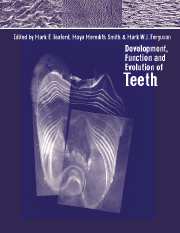Book contents
- Frontmatter
- Contents
- List of contributors
- Acknowledgements
- Part one Genes, molecules and tooth initiation
- Part two Tooth tissues: development and evolution
- 5 Evolutionary origins of dentine in the fossil record of early vertebrates: diversity, development and function
- 6 Pulpo-dentinal interactions in development and repair of dentine
- 7 Prismless enamel in amniotes: terminology, function, and evolution
- 8 Two different strategies in enamel differentiation: Marsupialia versus Eutheria
- 9 Incremental markings in enamel and dentine: what they can tell us about the way teeth grow
- Part three Evolution of tooth shape and dentition
- Part four Macrostructure and function
- Index
7 - Prismless enamel in amniotes: terminology, function, and evolution
Published online by Cambridge University Press: 11 September 2009
- Frontmatter
- Contents
- List of contributors
- Acknowledgements
- Part one Genes, molecules and tooth initiation
- Part two Tooth tissues: development and evolution
- 5 Evolutionary origins of dentine in the fossil record of early vertebrates: diversity, development and function
- 6 Pulpo-dentinal interactions in development and repair of dentine
- 7 Prismless enamel in amniotes: terminology, function, and evolution
- 8 Two different strategies in enamel differentiation: Marsupialia versus Eutheria
- 9 Incremental markings in enamel and dentine: what they can tell us about the way teeth grow
- Part three Evolution of tooth shape and dentition
- Part four Macrostructure and function
- Index
Summary
Introduction
Amniota, the group consisting of reptiles, birds, and mammals, is characterized by monotypic enamel, a hypermineralized tissue secreted exclusively by ectodermal cells, the ameloblasts. While the enamel of Tertiary, Quaternary, and Recent mammals has received much study (Koenigswald and Sander, 1997a; Chapter 8), that of reptiles, toothed birds, and mammal-like reptiles is much less well known. One reason is that most mammals have prismatic enamel, which is easily studied in thin sections with polarized light, whereas the enamel of most non-mammalian amniotes (summarily referred to as reptiles hereafter) lacks prisms. This prismless enamel can only adequately be studied with the scanning electron microscope (SEM) because the light microscope cannot resolve individual crystallites. Enamel types differing in crystallite arrangement thus can look the same in light micrographs. Published SEM surveys of reptile enamel do not predate the last decade (Carlson, 1990a, b; Dauphin, 1987a, b, 1988; Dauphin et al., 1988; Sahni, 1987). There are two additional reasons for the low level of interest in reptilian enamel structure. First, the main impetus for studying reptile enamel in the past was not interest in the matter per se but in the origin of mammalian prismatic enamel. Second, paleontologists and systematists working with mammals traditionally focus on the teeth because mammalian teeth are rich in characters compared with the postcranial skeleton. The reverse is true for non-mammalian amniotes.
The purpose of this chapter is to provide an overview of the structural complexity and diversity of reptilian enamel and to explore the evolutionary constraints on its structure, be they functional or phylogenetic.
- Type
- Chapter
- Information
- Development, Function and Evolution of Teeth , pp. 92 - 106Publisher: Cambridge University PressPrint publication year: 2000
- 46
- Cited by



